Biological Concepts — Lab 9 online
BIOLOGICAL DIVERSITY:
Microbial life; fungi; symbiotic relationships
|
Instructions: Study all the visual information in this online lab, plus the accompanying explanations. Be prepared to answer a few "check-in" questions to show that you were paying attention. |
|
PREFACE: This lab and the next three together illustrate the vast biological diversity, or BIODIVERSITY, of planet Earth. This biodiversity, emphasized in Chapter 18, also includes the many types of plants described in Chapter 11 and the microbial life forms emphasized in today's lab. PLEASE REVIEW the second half of Chapter 6 for a discussion of the classification by which our knowledge of this biodiversity is organized. |
MICROBIAL DIVERSITY
PROCARYOTES
|
Procaryotes are one-celled organisms whose cells lack a true
(membrane-bounded) nucleus and other eucaryotic organelles.
Procaryotes include the Archaebacteria, true bacteria, and Cyanobacteria.
Procaryotic cells: Cells without true nuclei, lacking many other structures found in eucaryotic cells. Procaryotic cell walls: Contain substances like muramic acid, absent in eucaryotes. Chemical diversity: Procaryotes have greater chemical diversity than eucaryotes. They can subsist on a greater variety of foodstuffs, have a greater range of chemical substances that can be tolerated, and can subsist in a variety of atmospheres, both with and without oxygen. Heterotrophic (organic molecules, mostly from other organisms) Cell shapes: Commonly "rod"-shaped, but many are spherical ("cocci"). Less common shapes: bent rods, pear-like, gentle spirals, corkscrews ("spirochete") Procarytoic chromosomes: Generally arranged in a single circular loop containing DNA but no histone proteins. Partial recombination may occur during conjugation. Most procaryotes also have small chromosome fragments that can detach from the main chromosome and exist separately for long periods as plasmids, small, circular samples of DNA similar to certain viruses. Archaea (Archaebacteria): A group of strict anaerobes (killed by oxygen) that include the methane-producers (methanogens), the extreme halophiles, and the extreme thermophiles. Their RNA sequences have only minimal homology to the RNA of other procaryotic or eucaryotic organisms, and the cell walls are also unique. True bacteria: The majority of procaryotes, with RNA sequences homologous to those of Cyanobacteria and eucaryotes (but not Archaebacteria). Most are heterotrophs. A few autotrophs use a variety of energy sources, but none contains chlorophyll a and none can split water in the Hill reaction. Cyanobacteria (= Cyanophyta, blue-green bacteria, or blue-green algae): All are similar to bacteria in structure and their RNA sequences are homologous. All are oxygen-tolerant autotrophs that can use sunlight for energy and CO2 as a carbon source. They contain chlorophyll a and can split water in the Hill reaction. A possible classification of Bacteria:
Viruses are fragments of nucleic acid (DNA or RNA, never both), often surrounded by protein, that can replicate only with the help of intact cells. (A few viruses also have capsules derived from host cell membranes.)
|
EUCARYOTE DIVERSITY
|
The study of RNA sequences offers new insights into the evolution of diversity among the Eucarya.
One-celled eucaryotes (formerly called Protista) possess
a diversity of locomotor adaptations: pseudopods for amoeboid locomotion,
flagella, and cilia. Some are non-motile. Photosynthesizing eucaryotes that do not develop from multicellular embryos are called Algae; a diversity of photosynthetic pigments exists among brown algae (Phaeophyta), green algae (Chlorophyta), red algae (Rhodophyta), and several groups of microscopic algae. The Eucarya are now classified into about five major groups: Unikonta (including amoebozoans, animals, and fungi), Excavata (Diplomonads, etc.), Rhizaria, Chromalveolata (a large and possibly heterogeneous group including ciliates, brown algae, and many others), and Archaeplastida (a group of photosynthetic organisms including red algae, green algae, and plants). Different locomotor adaptations have arisen among the Eucarya:
|
ONE-CELLED PROTISTS
Animal-like (non-photosynthetic)
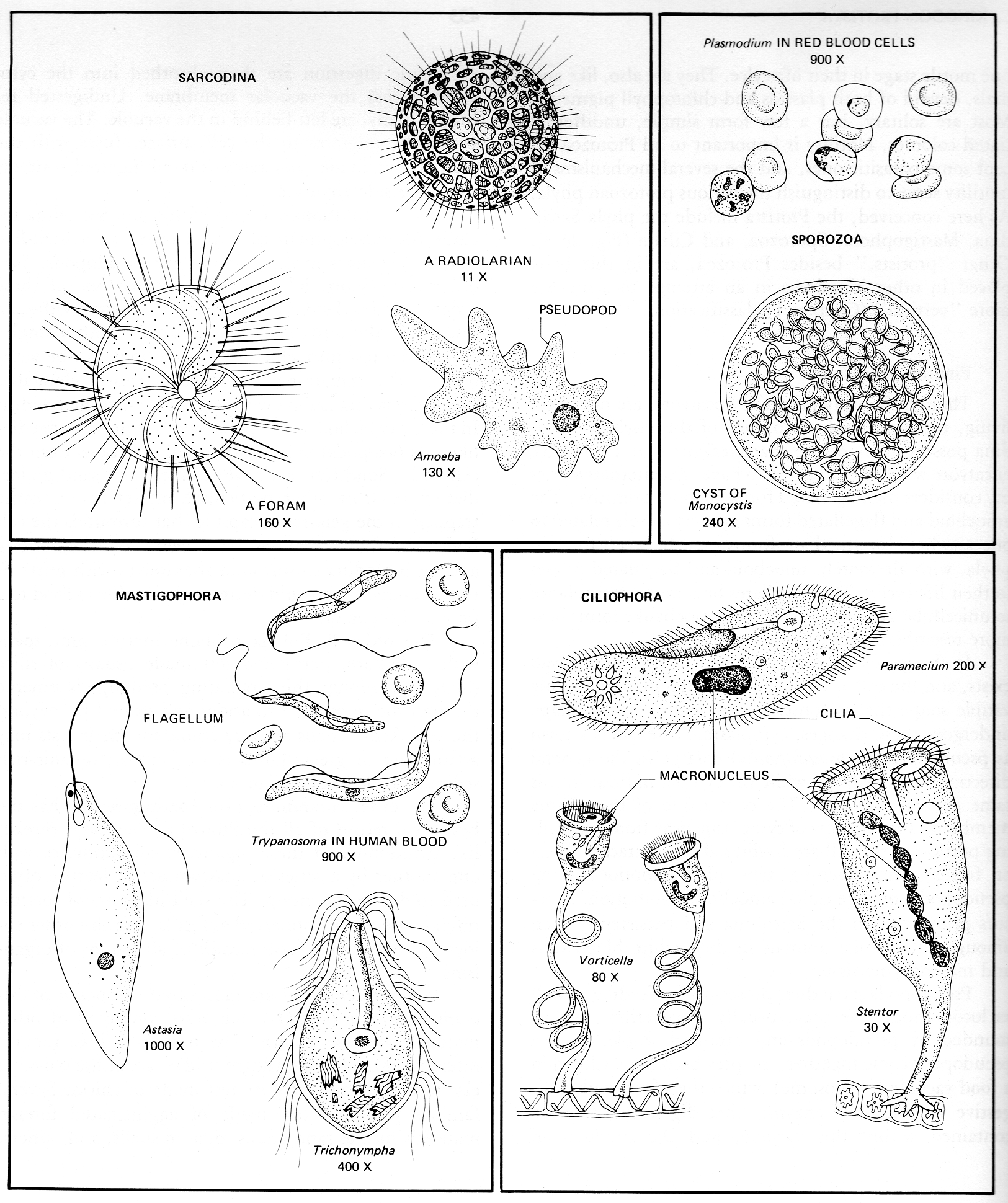
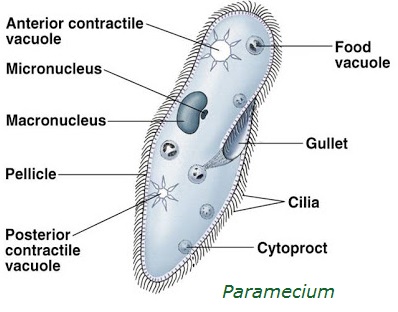
| 
| 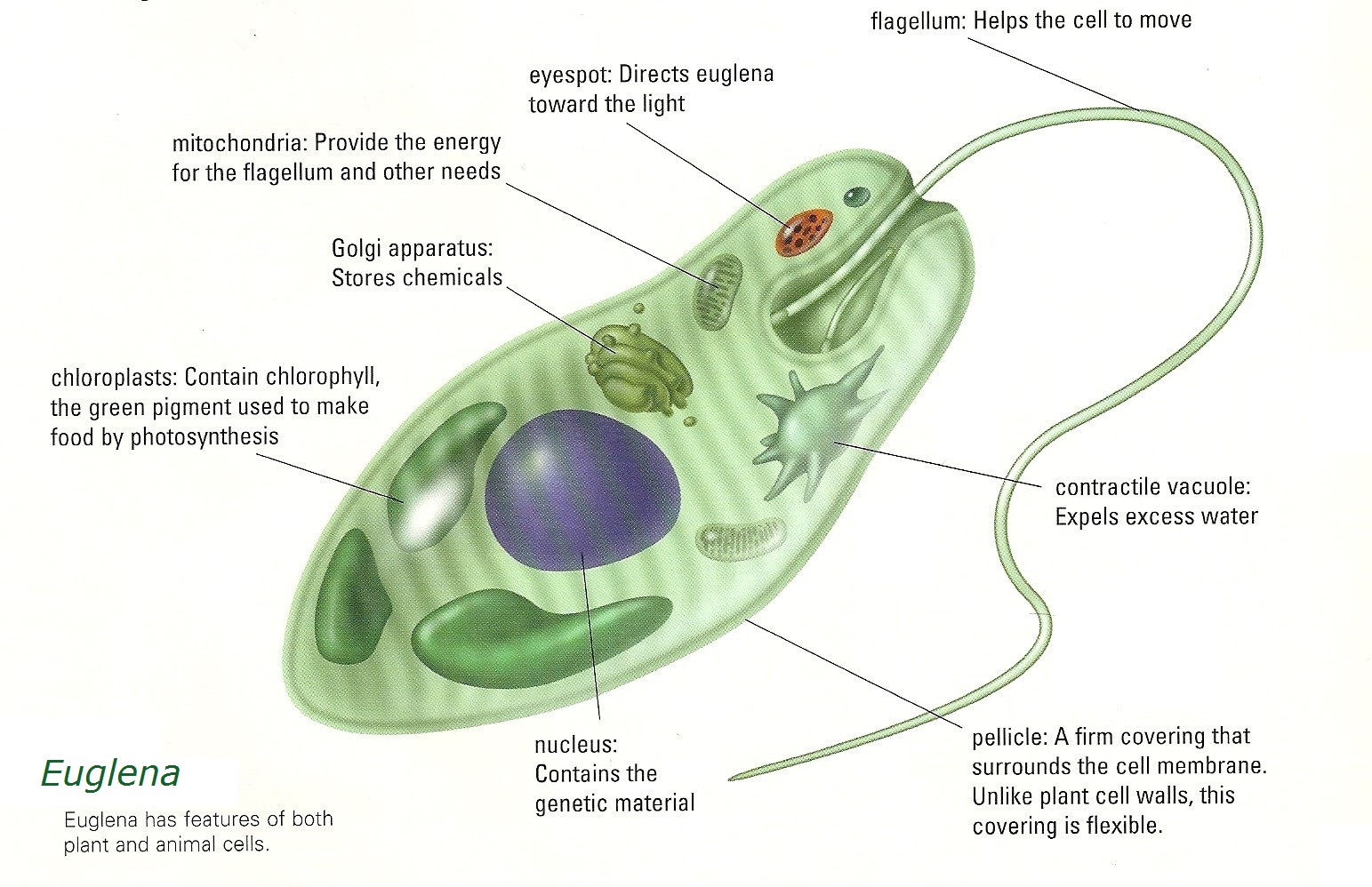
|
Trypanosoma life cycle
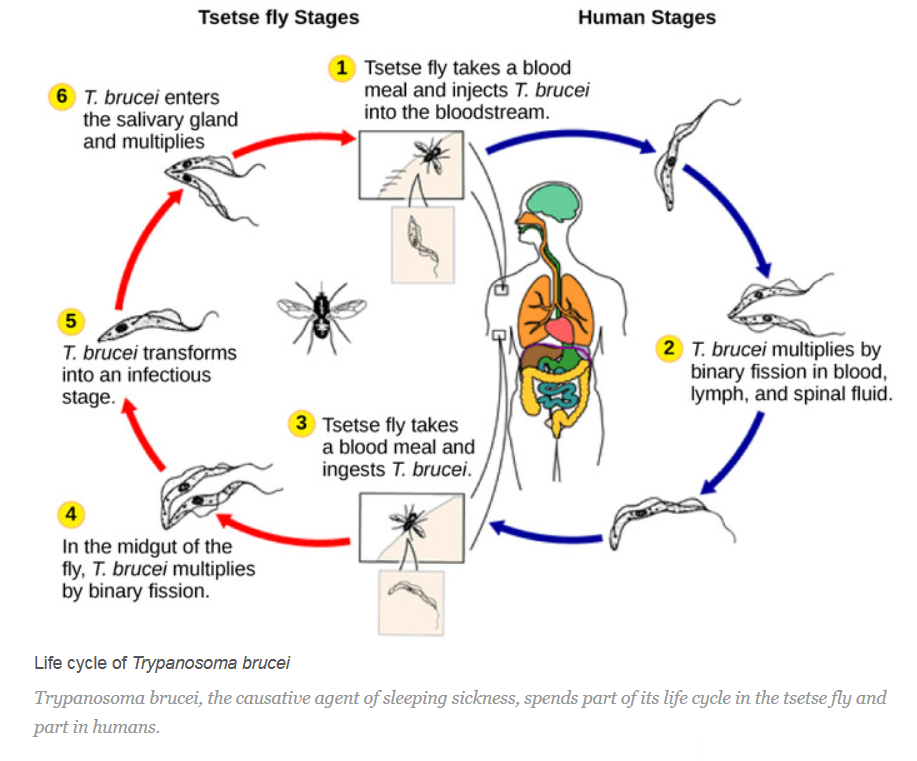
Amoeboid locomotion (movie clip)
Slime mold (J.T. Bonner film)
Plant-like (photosynthetic)
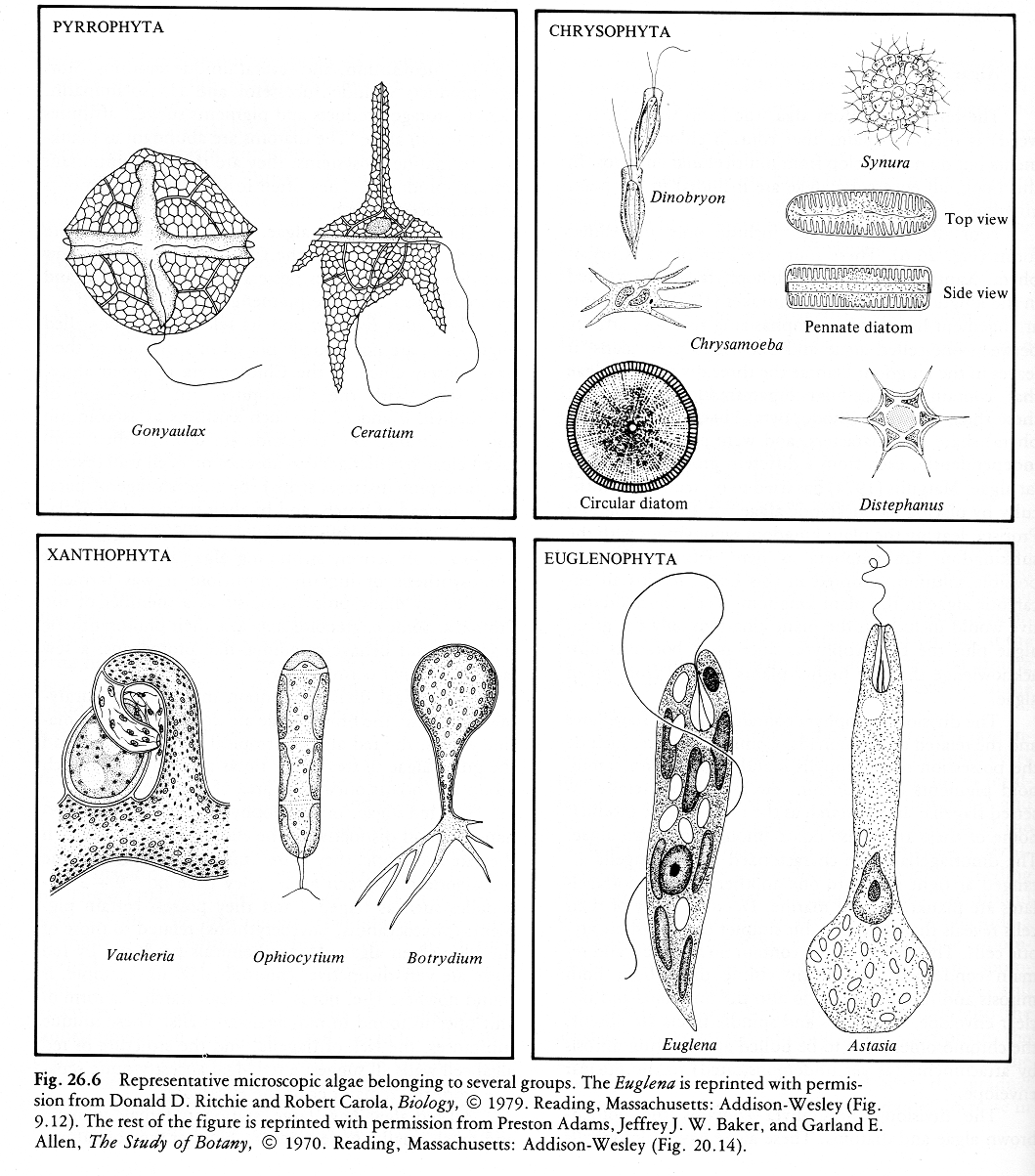
Possible family trees of Eucarya

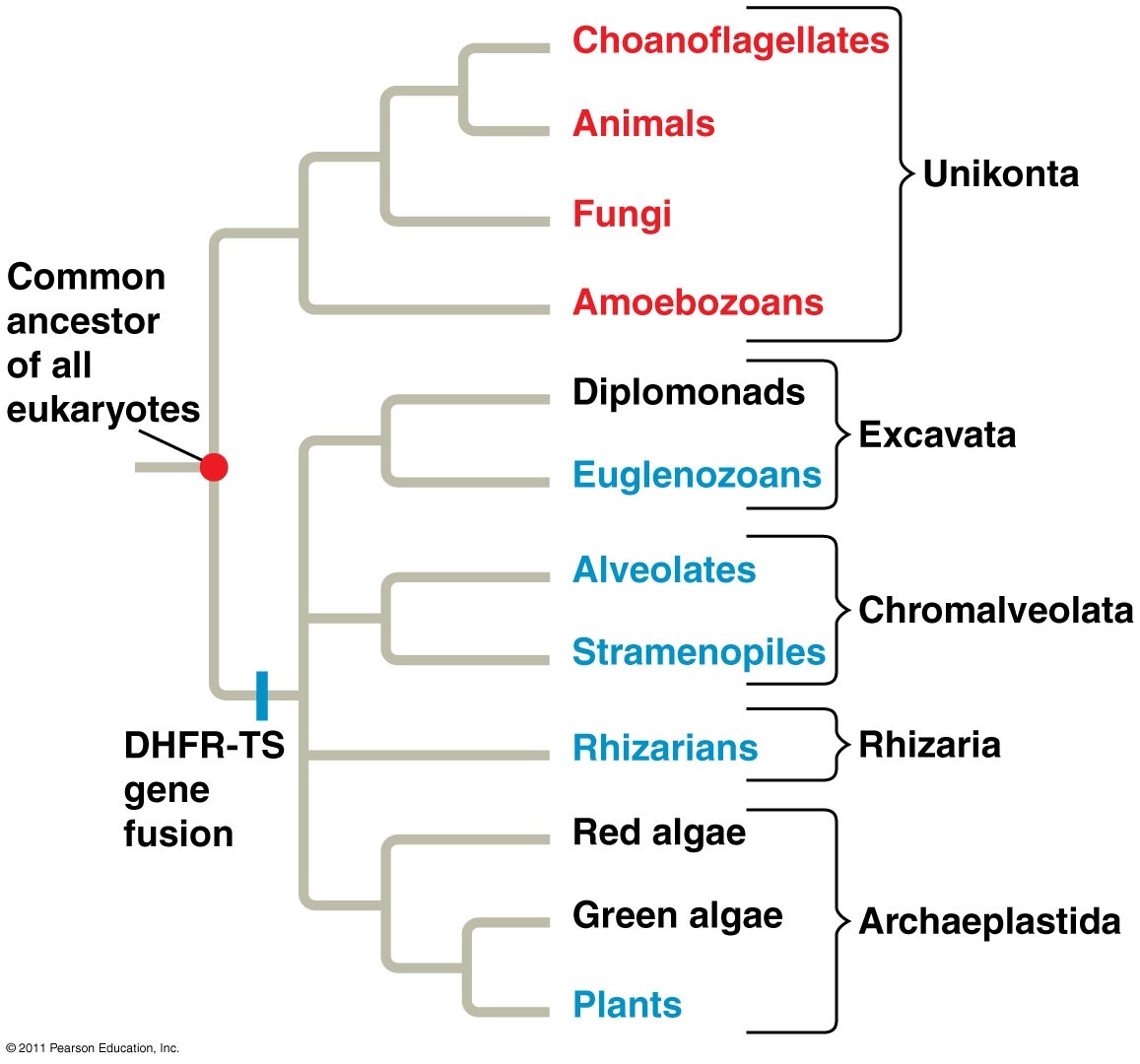
|
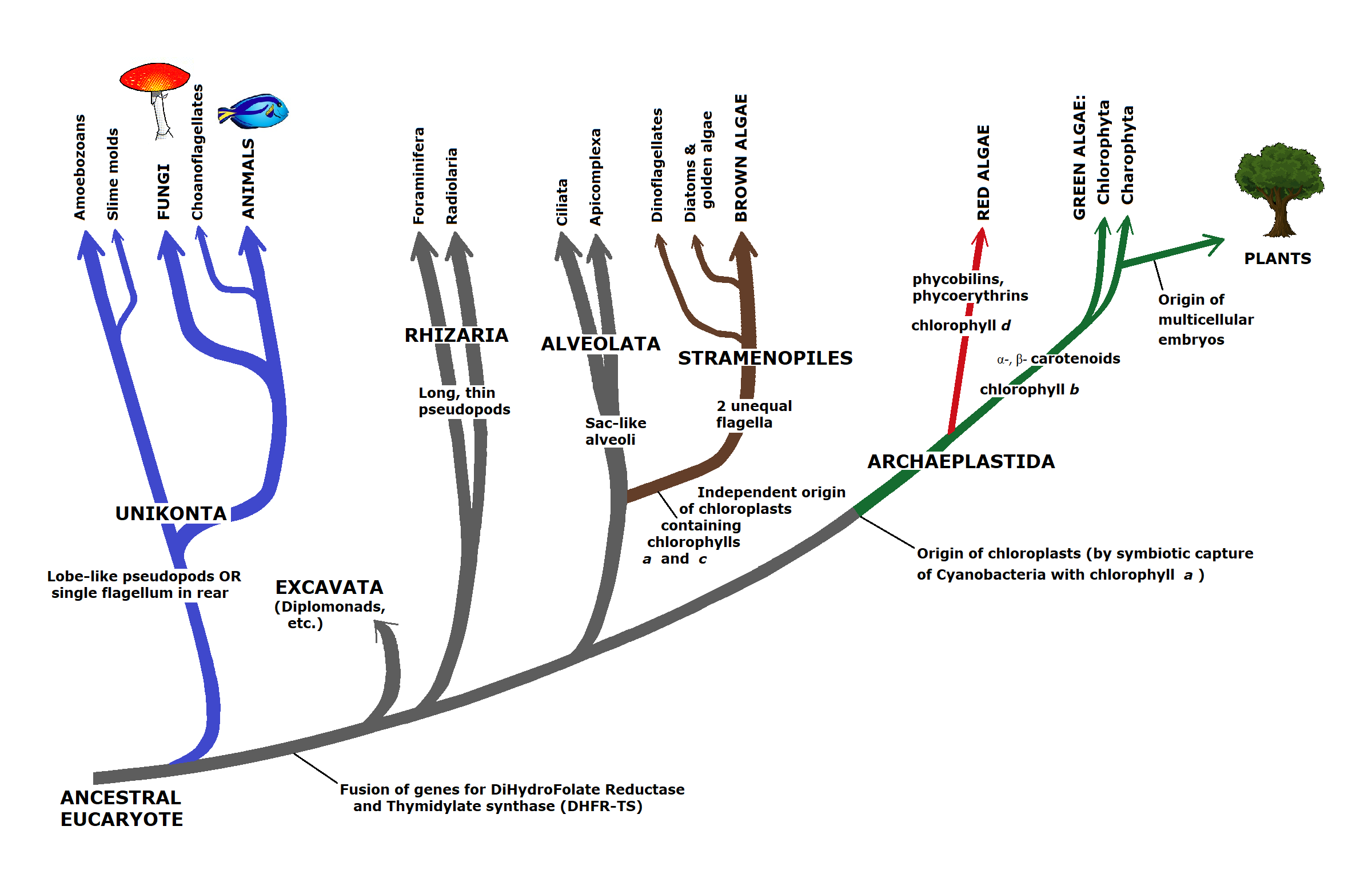
PHOTOSYNTHETIC PROTISTS ("ALGAE")





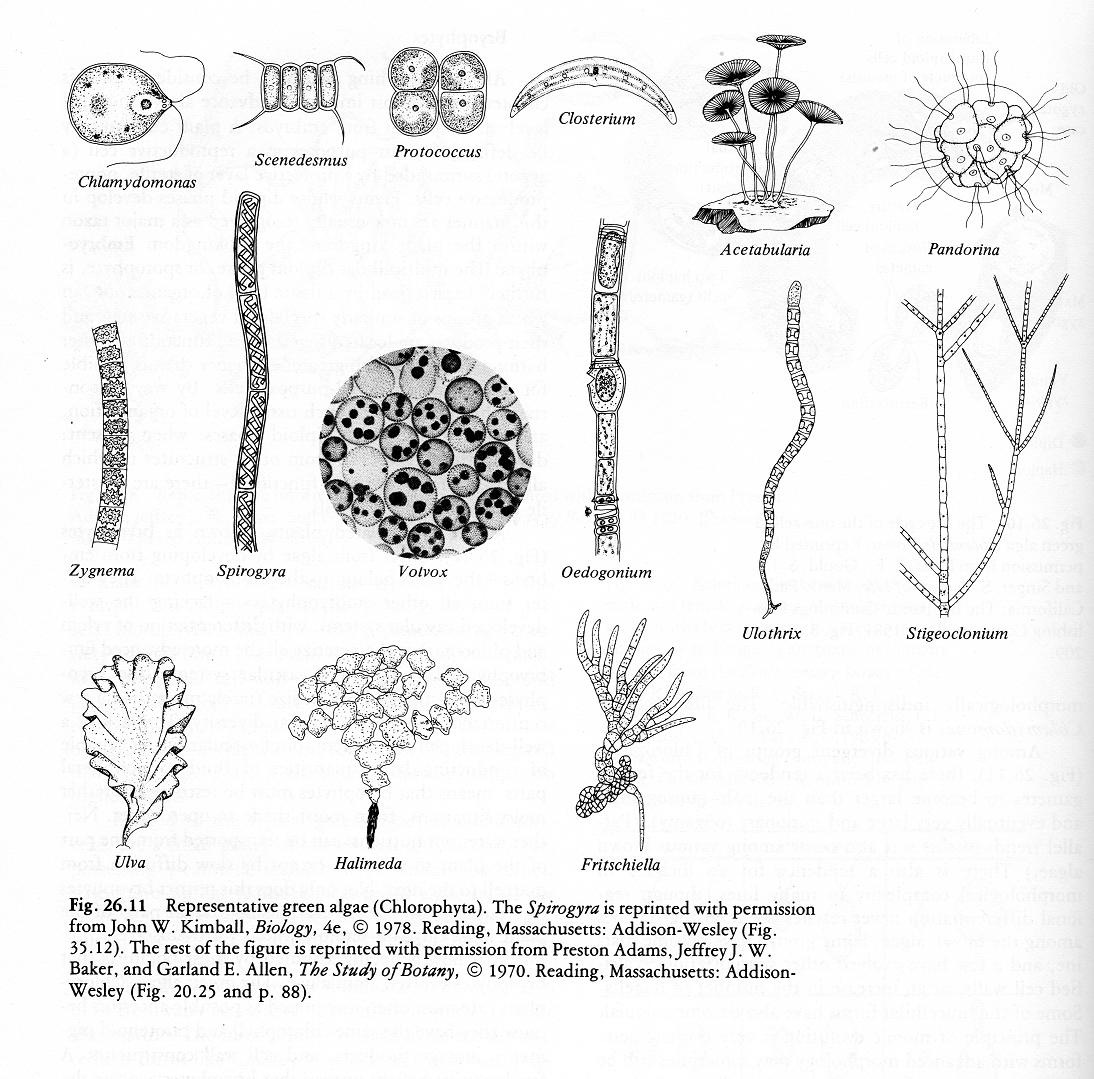

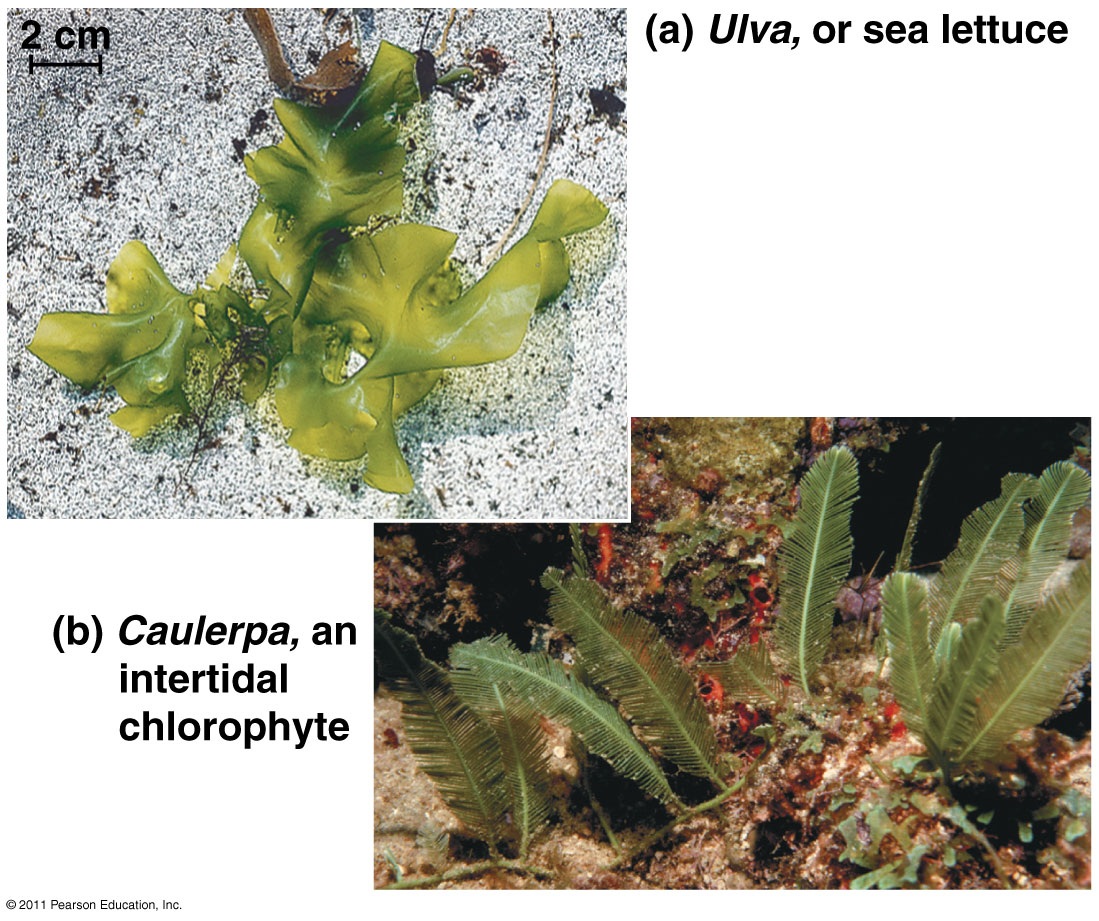

FUNGI (Kingdom MYCOTA)
FUNGI (MYCOTA)
|
The Mycota or Fungi are non-photosynthetic eucaryotes adapted
to absorptive nutrition. Slime molds have motile, unicellular, vegetative
stages, while true fungi form branched filaments (hyphae) that invade dead
or decaying material. All fungi form spores; the various groups of fungi
are distinguished by their means of spore formation. General characteristics of fungi: Plastids and chlorophyll are absent. Cell walls are made of chitin, not cellulose. Cell membranes sometimes break down to form binucleated cells or multinucleated aggregates. Reproductive structures vary, but spores are always produced. Nutrition is usually absorptive; many fungi live on dead or decaying matter (saprophytic), but some are parasitic instead. Fungi are important as decay organisms in freshwater and terrestrial ecosystems. Most prefer moist conditions for optimal growth. Slime molds: Organisms whose unicellular vegetative stages are either amoeboid or flagellated and resemble Amoebozoans. All types have a multinucleated or multicellular creeping stage that forms spore-producing bodies. Each spore develops into a new vegetative cell. Formerly considered to be fungi, but now usually put in their own group. True fungi (Eumycota): Fungi whose vegetative structure typically consists of a series of branching filaments (hyphae) forming a tuft (mycelium).
|
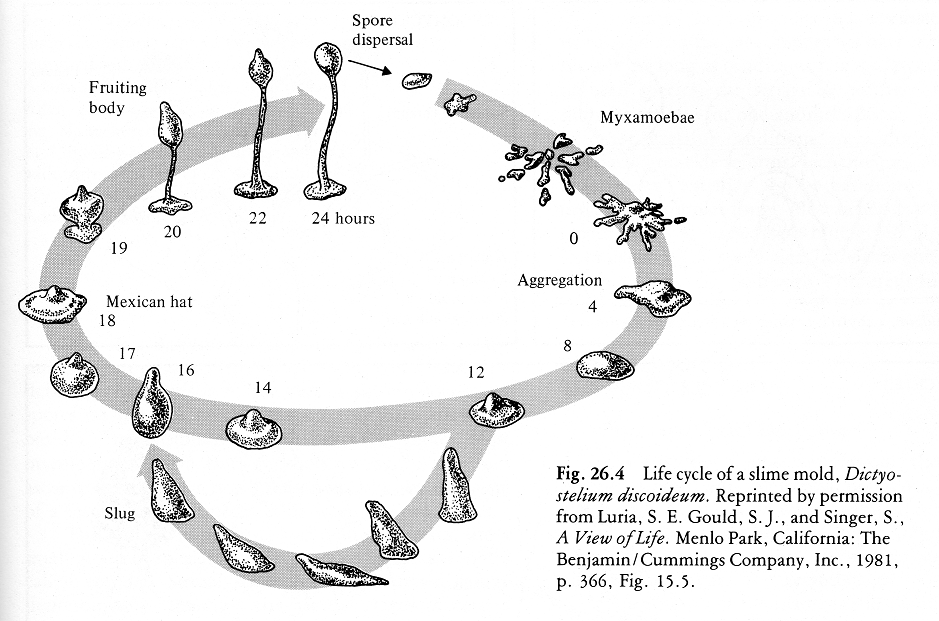

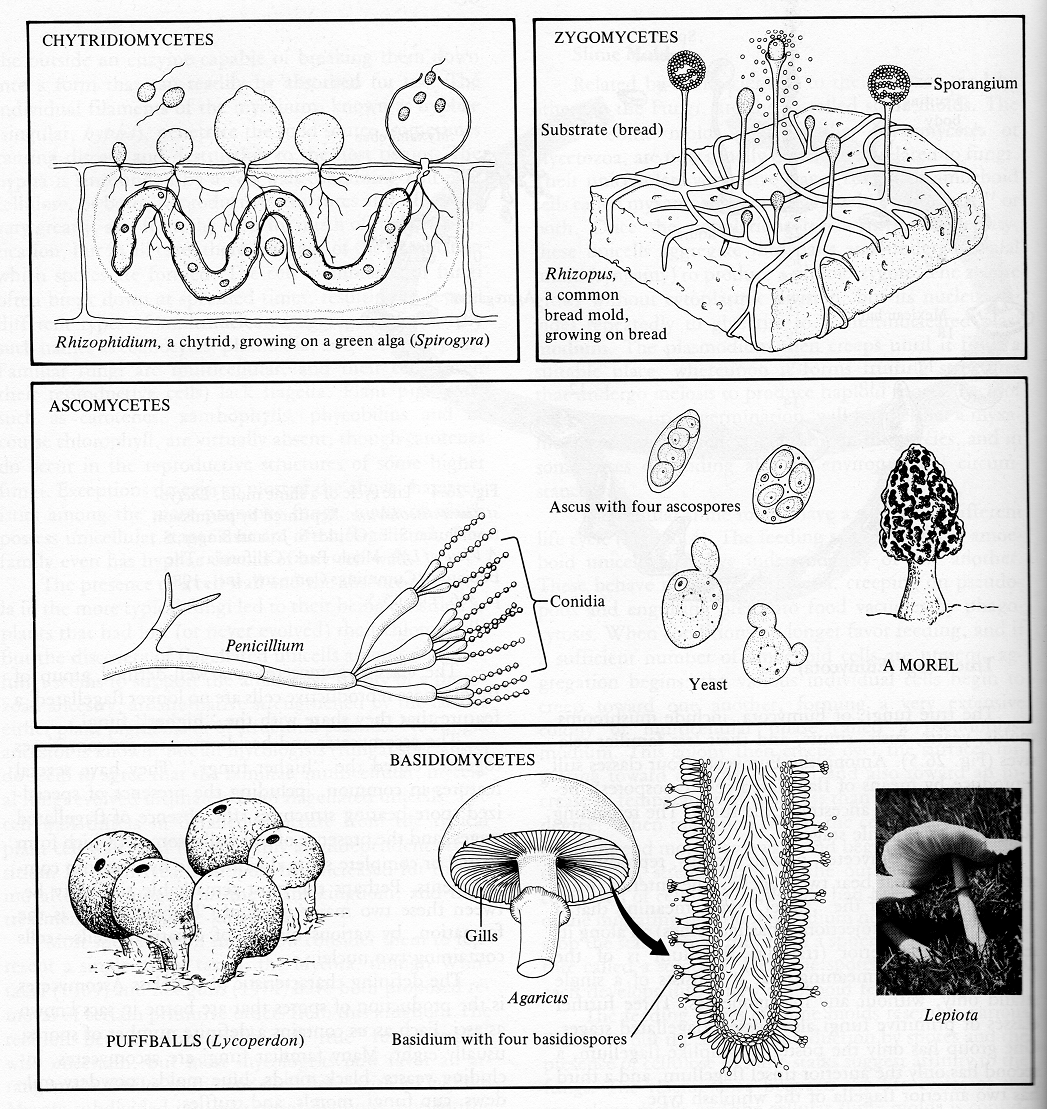
ZYGOMYCETES
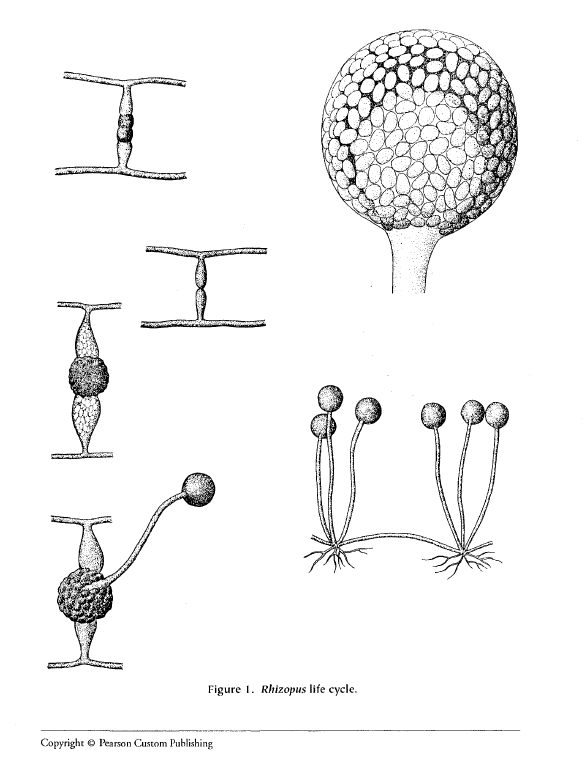
ASCOMYCETES

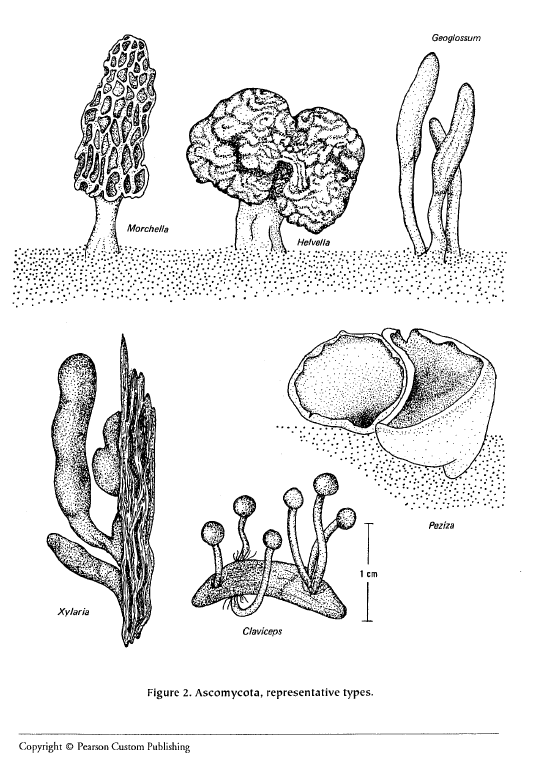
BASIDIOMYCETES

SYMBIOTIC RELATIONSHIPS
|
Symbiosis consists of two (or more) species living together.
Symbiosis greatly increases biodiversity because, as ecologists often say,
every new species creates many new niches and many new habitats for
other species to live either inside it or upon it:
The little bug has a little'er bug, and so on, ad infinitum!" Most cases of symbiosis begin as parasitism, a symbiosis where the parasitic species does harm to the host species, usually by feeding off its tissues. In such situations, natural selection among hosts favors those that can detect and defend against parasites, while natural selection among parasites favors those that can evade host defenses by causing as little pain and harm as possible. One big problem for parasites is that their habitat is the mortal body of their host; if they cause too much harm, they kill their host, and lose their habitat. Parasites therefore evolve smaller sizes and other adaptations that minimize the harm they do to the health and well-being of their hosts. Over the course of evolution, some parasites evolve to return some benefit to their hosts and keep the host alive and well. When the benefit and harm are balanced and equal, the relationship is called commensalism. Some parasitic or commensal species go even further and return more benefit to their hosts than the harm that they do, a situation called mutualism. (This is measured by determining that an increase in the formerly parasitic species results in an increase, not a decrease, in the host species population.) Mutualism benefits both species, so that natural selection favors adaptations in each that benefit the other species and make the relationship stronger. Among fungi (above), the Glomerulomycota exist almost exclusively as symbiotic colonies called mycorrhizae, living in associations with plant roots. The fungi benefit the plants by retaining moisture during dry periods, and the plant provides habitat for the fungus, including small compartments that maintain the conditions needed for fungal growth. Other fungi grow in symbiotic associations with algae (or sometimes Cyanobacteria) known as lichens. In a lichen, the photosynthetic partner uses sunlight to make sufficient food for both itself and the fungus. The fungus, in turn, retains moisture during dry periods and allows the moisture-dependent photosynthetic partner to grow on tree trunks or bare rock surfaces. |

Ants of the genus Pseudomyrmyx live inside the hollow "swollen thorns" of the
bull-horn acacia tree (Vachellia cornigera). They actively defend the tree against
herbivores such as goats. In return, the tree houses them inside the hollow
thorns and feeds them with sugary nectar from nectaries and protein-rich
secretions on the ends of leaflets.


These plants of the genus Yucca are pollinated by certain moths of the genus Megathymus.
Both species are dependent on this mutualism: the moth can only complete its life cycle
by laying its eggs inside the yucca that its caterpillars feed upon, and the yucca plants
cannot reproduce without the pollinating activity of the adult moths.

Several species get their teeth cleaned by smaller symbiotic species. The smaller "cleaning" species gets a free meal.

On occasion, an aggressive species take advantage of symbiosis by mimicking a "cleaning" species.
In this example, the saber-tooth blenny is able to get close enough to attack its prey
because it mimics a cleaning species, the cleaning wrasse.
· · · • • • • • · · ·
Click here for the
Check-In questions
—— Rev. Oct. 2020 ——